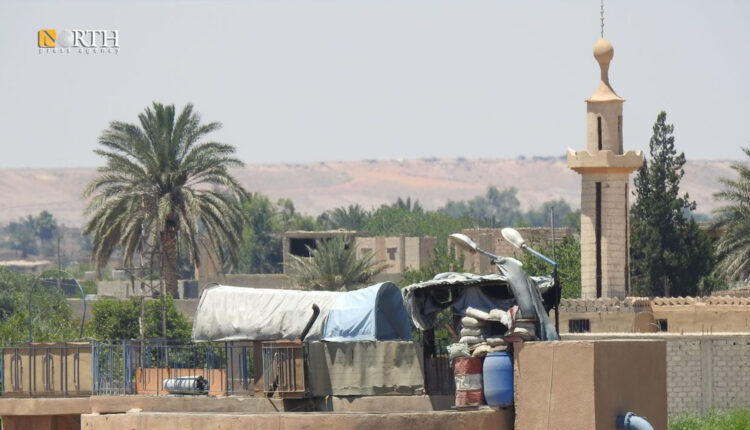
By Zana al-Ali
RAQQA, Syria (North Press) – Iran has been using a “Carrot and Stick” approach to attract and recruit young men wanted by the Syrian government and are included in the reconciliations. The high salaries that Iran offers tempt many people amid the dire economic conditions lived by most Syrians.
Iran has been facing faith-based rejection since controlling Deir ez-Zor Governorate, eastern Syria, in 2017. Nevertheless, it managed to recruit thousands of people through Shiitification. Recently, it has farmed out recruiting to close figures, such as tribal and religious leaders.
Iran seeks to form a new militia under the name of Hashemite Tribes Corps led by Nawaf Ragheb al-Bashir, head of al-Baggara tribe. Media reports said al-Bashir, backed by Iran, aims to fight the Syrian Democratic Forces (SDF) in areas east to the Euphrates River.
According to the reports, al-Bashir held a meeting on Sep.11 with Iraqi and Iranian officials in the town of al-Mayadin in the eastern countryside of Deir ez-Zor, which led to an agreement on forming the new militia.
The militia consists of militants affiliated with al-Bashir. He sought to attract tribal leaders to recruit militants in the militia by guarantying protection for the wanted by the Syrian government forces or by tempting them with money and financial gains.
Iran relied on a group of tribal leaders and businessmen to recruit as many youths as possible into the ranks of its armed militias. It also sought to gain the loyalty of the prominent figures in the community.
In the recent events that took place in Deir ez-Zor, al-Bashir incited Arab tribes and clans against the SDF in an evident hate speech, according to observers.
On Aug. 27, the SDF launched a military operation called “Security Reinforcement” with the support of the US-led Global Coalition on the eastern bank of the Euphrates River, specifically in Deir ez-Zor, “to eradicate ISIS sleeper cells, pursue criminals responsible for perpetrating injustices against the local population, and to track down smugglers who exploit the populace’s livelihoods.”
On Aug. 30, the SDF announced the dismissal of commander of Deir ez-Zor Military Council, Ahmad al-Khabil, known as Abu Khawla, from duty, for his involvement “in multiple crimes and violations, including communication and coordination with external entities hostile to the revolution, committing criminal offenses and engaging in drug trafficking, mismanaging of the security situation, his negative role in increasing the activities of ISIS cells,” according to the SDF.
The operation led to the eruption of clashes between the SDF and gunmen affiliated with the dismissed leader and with Nawaf al-Bashir, leader of al-Baggara tribe and a pro-Iranian figure whose groups are active in the western bank of the Euphrates which is under the control of the Syrian government forces and Iranian-backed militias.
Al-Bashir tried to take the advantage of the clashes in Deir ez-Zor to attract as many as possible to join the new Hashemite Tribes Corps militia, which was formed to implement Iran’s plans of gaining influence in the region.
Iran used the importance of the tribal lineage in this community as a start to infiltrate, especially the Hashemite tribes that have a historical connection to the Ahl al-Bayt, or the descendants of Prophet Muhammad, such as the al-Baggara, Mashahda, and al-Marasima tribes who all supported Iranian-backed militias.
Tribal loyalty contributed in strengthening the Iranian influence in Deir ez-Zor in areas west of the Euphrates. Those tribes believe that joining the Iranian side is better than the Syrian government, who failed to win them over.
Iran began with families from the village of Hatla in the east of Deir ez-Zor and al-Bashir and formed the Baqir Brigade and the Tribe Lions militia, of which the majority are from the same tribe, in addition to other regional and tribal militias affiliated with Iran’s Islamic Revolutionary Guard Corps (IRGC).
These militias are mostly led by Iranian leaders or by local commanders who take their orders from Iranian leaders. The local militias’ work is focused on smuggling, escorting Iranian trucks and protection of military posts.
The majority of tribal leaders in areas controlled by Iran and the government forces in Deir ez-Zor sided with Iran and formed brigades similar to the IRGC.
A number of these Iranian-backed militias were established on a tribal basis, so the recent event in Deir ez-Zor prompted al-Bashir and his followers to unite these militias under one name.
Hashemite Tribes Corps
This new militia consists of 1,000 militants, most affiliated with al-Bashir. They are stationed in the village of al-Hussainiyah in the east of Deir ez-Zor city to defend seven villages in the eastern bank of Euphrates River, which is under Iranian-backed militias with the support of the IRGC.
Iran selected several figures to work with, such as Abdullah al-Shlash, the man in charge of reconciliations between the opposition and the Syrian government, and Ghanim al-Suleiman, who was formerly an official in the Tribes Office in the Islamic State (ISIS). Now he works as a member in the Reconciliation Committee. Iran also worked with Ahmad Salama, former mayor of the town of Shumaytiyah in the northwest of Deir ez-Zor. Locally, he is known as a mediator that facilitates working with the Iranian-backed militias. Fares al-Khedr attracts intellectuals of Deir ez-Zor to work for Iran and recruits the youth in the new militia.
According to media sources in areas west of the Euphrates, al-Shlash has managed to recruit more than 80 young men, whereas al-Suleiman managed to recruit 50. Fares al-Khedr recruited more than 150 men, all from Deir ez-Zor up until the end of August.
The sources further added, the new recruits are paid a monthly salary of 500,000 Syrian pounds (SYP, which equals about $33), in addition to receiving food rations and security cards that enable them to move freely in the region.
